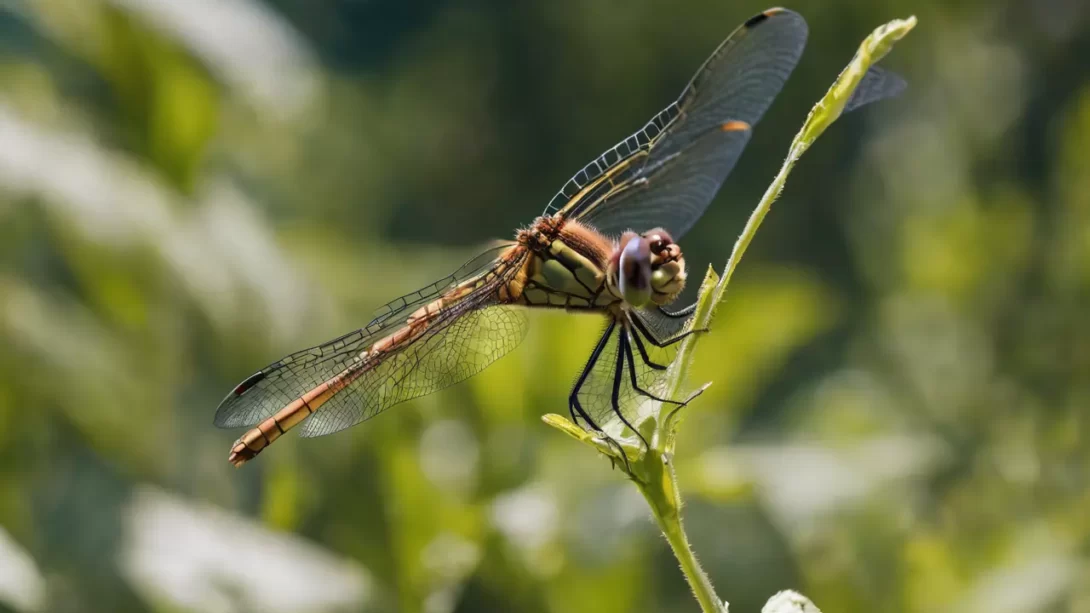Dragonflies are remarkable creatures, known for their agile flight and vivid colors. These insects are not only fascinating from a biological standpoint but also play a crucial role in various ecosystems, particularly as predators controlling insect populations. This article delves into the reproductive habits of dragonflies, with a focus on understanding where and how they lay their eggs.
Dragonflies
Dragonflies belong to the order Odonata and are characterized by large, multifaceted eyes, two pairs of strong transparent wings, and elongated bodies. They undergo a unique life cycle that includes three stages: egg, nymph (larva), and adult. Dragonflies are aquatic during their nymph stage, making their choice of egg-laying sites critical for their offspring’s survival. They are also vital for the ecosystem, serving as both predators and prey in aquatic food chains.
Dragonfly Reproduction
The reproduction process of dragonflies is intricate and starts with an elaborate courtship and mating ritual. Males typically claim territories near suitable egg-laying sites and court females with specific flight patterns and displays. After mating, the female dragonfly is ready to lay her eggs, a process deeply influenced by environmental factors and the specific needs of her offspring.
Egg-Laying Habitats of Dragonflies
Dragonflies lay their eggs in various aquatic environments, with the choice of habitat varying significantly among different species:
- Ponds and Lakes: Many dragonflies prefer still or slow-moving waters like ponds, lakes, and slow-flowing streams. These water bodies provide a safer environment for eggs and nymphs, away from strong currents.
- Streams and Rivers: Some species are adapted to faster-moving waters and lay their eggs in streams and rivers. These habitats often have cleaner water, which is crucial for the development of dragonfly nymphs.
- Wetlands and Marshes: Wetlands and marshes are also popular egg-laying sites, offering abundant vegetation that provides ideal conditions for eggs and nymphs.
The choice of habitat is influenced by factors such as water quality, availability of food sources, and presence of vegetation, which offer shelter and hunting grounds for the developing nymphs.
The Process of Egg-Laying
Understanding how female dragonflies lay their eggs is key to appreciating their complex life cycle:
- Oviposition: This is the process by which a female dragonfly deposits her eggs. Depending on the species, this can be done while hovering above the water, tapping the water’s surface, or even submerging partially or completely to attach eggs to underwater plants.
- Egg Placement: The eggs are usually laid in or near water bodies. Some species lay eggs on the surface of the water, while others insert them into aquatic plants or mud.
- Species-Specific Behavior: Egg-laying behavior varies significantly among species. For example, some dragonflies lay eggs solitarily, while others may do so in groups.
Development of Dragonfly Eggs
Once the eggs are laid, they enter the next crucial phase of their development:
- From Eggs to Nymphs: The eggs hatch into nymphs, also known as larvae. This stage is aquatic, and the nymphs are voracious predators, feeding on various aquatic organisms.
- Growth and Metamorphosis: Dragonfly nymphs go through a series of molts as they grow. This stage can last anywhere from a few months to several years, depending on the species and environmental conditions.
- Transition to Adult: The final molt transitions the nymph into an adult dragonfly. This metamorphosis involves significant physiological changes, including the development of wings.
Threats to Dragonfly Reproductive Habitats
The habitats where dragonflies lay their eggs are under threat from various environmental pressures:
- Pollution: Water pollution from agricultural runoff, industrial waste, and urbanization can degrade the quality of aquatic habitats, affecting the survival rate of dragonfly eggs and nymphs.
- Habitat Destruction: The loss of wetlands, ponds, and streams due to human activities poses a significant threat to dragonfly populations.
- Climate Change: Changes in temperature and weather patterns can alter aquatic ecosystems, impacting the breeding and development cycles of dragonflies.
Conservation Efforts
The preservation of dragonfly habitats is crucial not only for their survival but also for maintaining the ecological balance they help uphold. Here are some key conservation efforts:
- Protecting Aquatic Ecosystems: Efforts to conserve and restore ponds, wetlands, and streams are vital. This includes advocating for policies that protect these areas and participating in local restoration projects.
- Reducing Pollution: Minimizing water pollution involves both individual and collective actions. This can be achieved by promoting sustainable agricultural practices, reducing industrial waste, and encouraging responsible waste disposal.
- Community Involvement: Community education and involvement are crucial. Raising awareness about the importance of dragonflies and the threats they face can lead to greater conservation efforts. Community science projects, like dragonfly surveys and monitoring, can also contribute valuable data.
Conclusion
Dragonflies, with their intricate life cycle and reliance on specific aquatic habitats for reproduction, are fascinating creatures that play a significant role in our ecosystems. Understanding where and how they lay their eggs is crucial for anyone interested in these captivating insects or involved in their conservation.
The survival of dragonflies is closely tied to the health of their aquatic environments. As such, the conservation of these habitats is imperative. By engaging in and supporting conservation efforts, we can ensure that dragonflies continue to thrive and maintain the ecological balance in our natural world.
In conclusion, dragonflies are more than just an intriguing part of our natural heritage; they are an integral part of the ecosystem that requires our attention and protection. Through conscious efforts to preserve their habitats, we can ensure that these remarkable insects continue to dazzle future generations with their aerial acrobatics and colorful presence.



